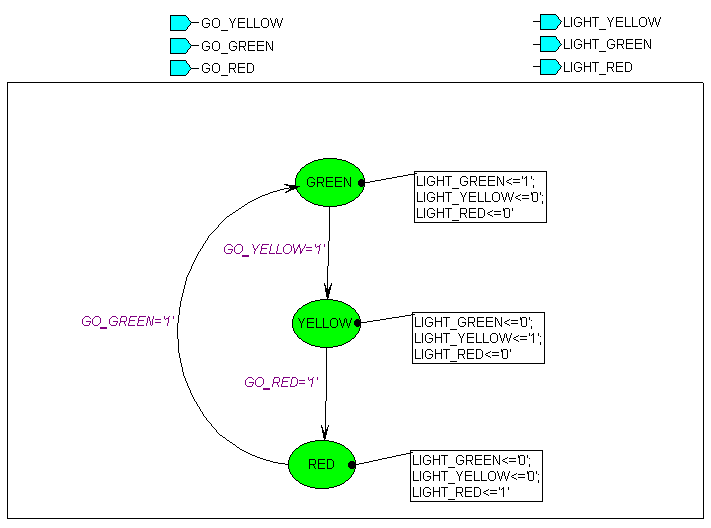
Tutorial Contents
Introduction
Comparison of State Machine
Description Methods
The Purpose of This
Tutorial
Creating a State Diagram
Implementation
Creating BLACKJACK Design
Using New Source File
Wizard
Adding Ports
Adding Extra Ports
Defining Additional
Variables
Adding a Reset State
Adding Initialization
Actions
Adding a State to Request a
Card
HDL Code Generation
Receiving and Handling of
the New Card
Analyzing the Total Score
Testing the Final Score
Assigning Condition
Priorities
Selecting State Encoding
Compiling the Design
Locating and Correcting
Errors
Simulation
Conclusion
State machine editors allow simple and easy graphical design entry. Since the state designs can be easily retargeted to any devices, the state editors are becoming very popular with designers who value technological independence. This tutorial is for Active-VHDL users who want to learn how to design with the state machine editor, which is used for graphical entry of VHDL designs.
Comparison of State Machine Description Methods
Let’s consider a very simple state machine that is used for controlling traffic lights. Since the best way to start any state machine design is with verbal description, let’s describe the operation of a traffic lights controller as follows:
The controller is based on a timer
that switches all traffic lights in a predetermined sequence.
When the red light is on and the timer signals that the green
light should be lit (GO_GREEN signal goes to High state),
turn on the GREEN signal and turn off other signals. When the
green light is on and the timer signals that the yellow light
should be lit (GO_YELLOW signal goes to High state), turn
on the YELLOW signal and turn off other signals. When the yellow
light is on and the timer signals that the red light should be
lit (GO_RED signal goes to High state), turn on the RED
signal and turn off other signals.
State diagram is a graphical method of a state machine description. As an example, a state diagram for traffic lights controller is shown below:

State machines can be converted into HDL code, which can then be converted into a physical implementation (netlist) by logic synthesis software.
A VHDL description of a traffic lights controller is shown below:
entity lights is
port (CLK: in STD_LOGIC;
GO_GREEN: in STD_LOGIC;
GO_RED: in STD_LOGIC;
GO_YELLOW: in STD_LOGIC;
LIGHT_GREEN: out STD_LOGIC;
LIGHT_RED: out STD_LOGIC;
LIGHT_YELLOW: out STD_LOGIC);
end;
architecture lights_arch of lights is
type LIGHTS_type is (GREEN, RED, YELLOW);
signal LIGHTS: LIGHTS_type;
begin
process (CLK)
begin
if CLK'event and CLK = '1' then
case LIGHTS is
when GREEN =>
if GO_YELLOW='1' then
LIGHTS <= YELLOW;
end if;
when RED =>
if GO_GREEN='1' then
LIGHTS <= GREEN;
end if;
when YELLOW =>
if GO_RED='1' then
LIGHTS <= RED;
end if;
when others =>
null;
end case;
end if;
end process;
LIGHT_GREEN <= '1' when (LIGHTS = GREEN) else
'0' when (LIGHTS = RED) else
'0' when (LIGHTS = YELLOW) else
'0';
LIGHT_YELLOW <= '0' when (LIGHTS = GREEN) else
'0' when (LIGHTS = RED) else
'1' when (LIGHTS = YELLOW) else
'1';
LIGHT_RED <= '0' when (LIGHTS = GREEN) else
'1' when (LIGHTS = RED) else
'0' when (LIGHTS = YELLOW) else
'0';
end lights_arch;
The main advantages and disadvantages of state machine designs are listed in the table below.
Verbal Description State Diagram HDL Description
| compact | very compact | lengthy |
| easy to read by humans | very easy to read by humans | hard to read by humans |
| difficult to implement | easy to implement | easy to implement |
| self-documenting | requires documentation |
This tutorial will teach you how to use Finite State Machine Editor for entering state machine diagrams and logic synthesis of the designs. We assume that you are familiar with the Active-VHDL application.
The sample design created in this tutorial is a state machine which plays the Blackjack game.
The purpose of the game is to select a number of cards which sum will be as close to 21 as possible. Each card has a decimal value between 2 and 11, where 11 is called ACE and can be counted as 1 if desired. The player with the highest number but lower than 21 will be the winner.
A request for an additional card is indicated by the SAY_CARD output (this signal is High or logical 1 when active), which is generated each time when the total sum of all cards is less then 17. However, it can never be generated if the total sum of cards exceeds 21.
The arrival of a new card is flagged by the NEW_CARD signal changing from 0 to 1.
The machine should output the SAY_BUST signal when the sum of cards exceeds 21. In case the total score is between 17 and 21, the machine should output the SAY_HOLD signal.
The total score should be shown on the TOTAL output. After reaching the SAY_HOLD or SAY_BUST condition, the machine should stay in the last state until the NEW_GAME (reset) signal is flagged on the input.
The NEW_GAME signal resets the state machine.
The machine will be implemented by drawing a state diagram. The diagram will be automatically converted into the corresponding VHDL code. Then, you can verify the functionality of the machine by simulating the code in the VHDL simulator.


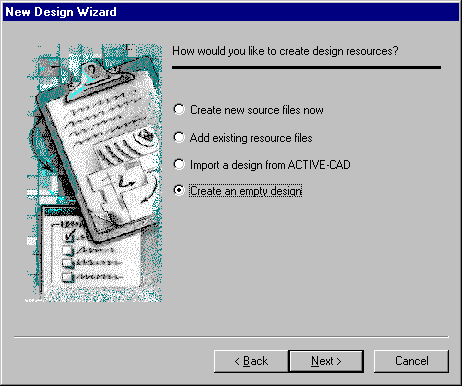
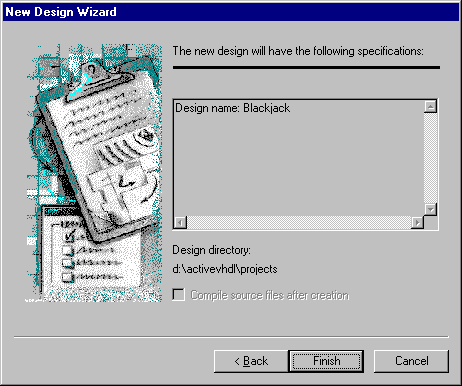
To open a new State Editor
window, select State Diagram from New in the File
menu.
Using a series of the successively appearing wizard windows, you
can create a new design.
To create a state diagram pattern:

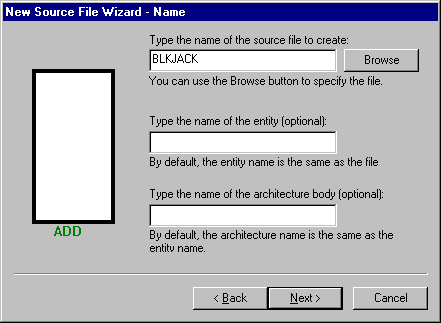

Note: The default file extension of state diagrams is *.ASF and the new file will be called BLACKJACK.ASF.
To add a new port in the Design Wizard - Ports window, perform the following operations:
All assigned port names are
displayed in the box above the New button and in the
symbol preview area, which is located to the left of the port
name listing.
Using the procedure described above, enter the following ports:
To enter the bus range [3;0] for
the CARD signal, click the Port button to open the Port
Type dialog. Then select the STD_LOGIC_VECTOR port type and
enter the bus range using the arrays in the Range field.
You can also enter the bus range using the Array Indexes
field in the Design Wizard - Ports dialog box.
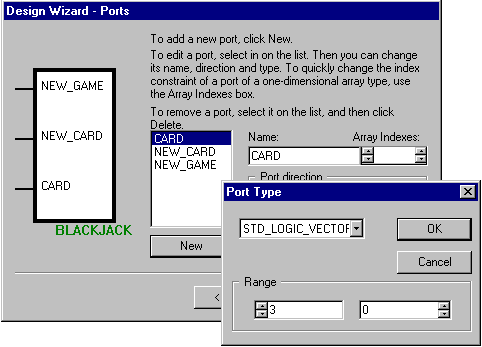
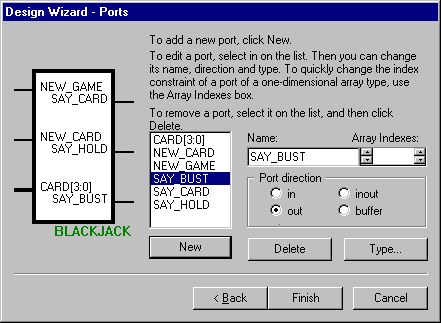
Note that all the assigned I/O ports appear within the outline of the symbol, which is displayed on the left-hand side of the above window.
NOTE: State Editor supports only synchronous state machines, which means that all transitions from one state to another are performed only at the clock transitions and a design cannot operate without a clock signal.
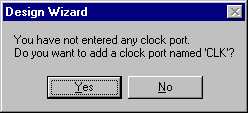
The new state diagram created by Design Wizard is shown
below:
NOTE: If you select multiple machines, they will be converted into separate and concurrent processes in VHDL.

Additional I/O ports can be added at any time to the state diagram by clicking the Output/ Input Port buttons, located at the bottom of the vertical toolbar. Since we need an output port showing the total score of the Blackjack game, let’s add it now.
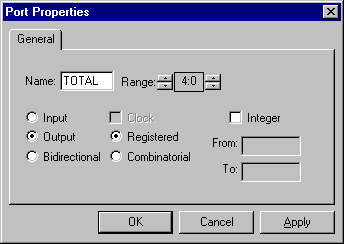
The Port Properties window allows you to define the selected input signal as a clock, and the output ports as either combinatorial or registered. The Registered ports hold the set value in an additional register. The combinatorial outputs change any time the input conditions change.
NOTE: Since the total value of all cards can be as high as 26 (the highest total at which a new card is drawn is 16 and the highest value of the new card can be 10), the TOTAL port has to have a binary range from 0 to 31 which requires 5 bits of data [4:0].
New output ports listed in the upper right-hand corner of the State Editor main screen should look as shown below:
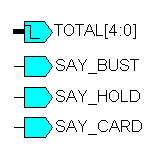
The state machine needs to know if
any of the cards is an ACE, because when the score exceeds
21 (with ACE counted as 11), the ACE can be counted
as 1 to lower the total value below 21.
The following procedure describes how to define a new variable
called Ace:


Each state machine needs to be initialized. In case of the Blackjack game the initialization takes place when a new game is started. Let’s add such initialization of all output ports to the state diagram right now.

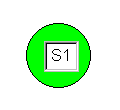
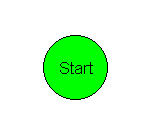
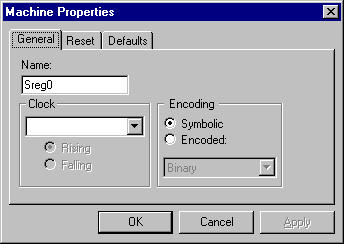

The Machine Properties window has several tabs for grouping different options within the window. Click the Reset tab and select the following:
This will assure that the NEW_GAME signal will be used as machine reset and when it is activated, the machine will automatically enter the Start state.
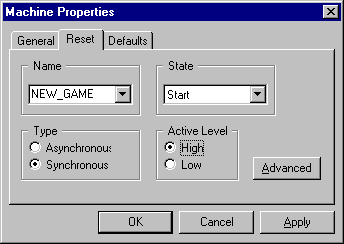
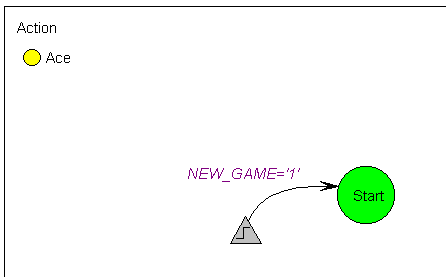
NOTE: The triangular reset symbol is not a state; it indicates that the associated transition will be executed any time this condition is met and will be carried out regardless of the current state of the machine. The reset transition is shown for documentation purpose only.
Once the reset condition is met, the machine will enter the Start state. To define actions that follow the reset, we will need to create an entry action. The entry action is automatically attached to the top of the state symbol and indicates that the specified code is executed only once, when the machine enters this state.
Ace := false;
TOTAL <= "00000";
SAY_CARD <= '0';
SAY_HOLD <= '0';
SAY_BUST <= '0';
Note that you have to use the VHDL syntax:
The above listed entry actions are shown below:
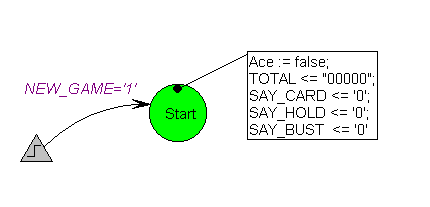
NOTE: Combinatorial output port assignments in the reset state are also used as default values in other states. This means that the output will be set to the default value in all states, even where the value was not explicitly indicated. In this example, SAY_BUST will be ‘0’ in all states unless you add the SAY_BUST <= ‘1’ action.
Adding a State to Request a Card
Once a reset has been performed, the state machine should start by requesting a card. This will be accomplished by adding the Hit_me state.
NOTE: The transition from the Start state to the Hit_me state is unconditional and it will be automatically executed in the next clock cycle, after entering the Start state (it means that the Reset state will last for one clock cycle).
To flag the request for a new card, the SAY_CARD should be set to ‘1’. Since this signal should remain active all the time in this state, we have to use the state action and not the entry action.
NOTE: State actions are executed on each clock cycle as long as the machine remains in the given state. Entry Action is performed only while entering the selected state. The Exit Action is performed upon leaving the previously active state.
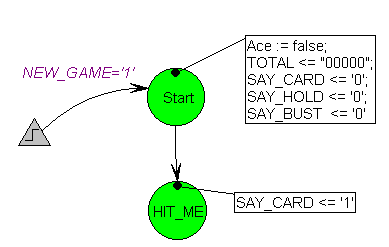
At this point, a section of the state machine has been created. Before the design gets bigger, we will inspect the code being generated to show how diagram elements correspond to the generated code.
NOTE: The HDL code generation process checks for some diagram problems but does not check your VHDL statements. A full syntax check will be performed later on when the design is synthesized.
NOTE: It is essential that you learn to relate the code that is being generated to the elements on the drawing. State editor uses standard templates to create the VHDL design. Understanding VHDL constructs is very helpful while debugging a design with a VHDL simulator.
The VHDL code generated by State Editor can be divided into several sections.
library IEEE;
use IEEE.std_logic_1164.all;
use IEEE.std_logic_arith.all;
use IEEE.std_logic_unsigned.all;
library METAMOR;
use METAMOR.ATTRIBUTES.all;
entity blackjack is
port (CARD: in STD_LOGIC_VECTOR (3 downto 0);
CLK: in STD_LOGIC;
NEW_CARD: in STD_LOGIC;
NEW_GAME: in STD_LOGIC;
SAY_BUST: out STD_LOGIC;
SAY_CARD: out STD_LOGIC;
SAY_HOLD: out STD_LOGIC;
TOTAL: out STD_LOGIC_VECTOR (4 downto 0));
end;
architecture blkjack_arch of blackjack is
-- SYMBOLIC ENCODED state machine: Action
type Action_type is (HIT_ME, Start);
signal Action: Action_type;
begin
--concurrent signal assignments
--diagram ACTIONS;
Action_machine: process (CLK)
--machine variables declarations
variable Ace: BOOLEAN;
begin
if CLK'event and CLK = '1' then
if NEW_GAME='1' then
Action <= Start;
Ace :=false;
TOTAL <="00000";
else
case Action is
when HIT_ME =>
when Start =>
Action <= HIT_ME;
when others =>
null;
end case;
end if;
end if;
end process;
-- signal assignment statements for combinatorial outputs
SAY_CARD_assignment:
SAY_CARD <= '1' when (Action = HIT_ME) else
'0';
SAY_HOLD_assignment:
SAY_HOLD <= '0';
SAY_BUST_assignment:
SAY_BUST <= '0';
end blackjack_arch;
Receiving and Handling of the New Card
Once a new card has been requested, the machine should wait until it is received. The arrival of the new card will be marked by the NEW_CARD signal. The following will add a design section that handles the NEW_CARD signal:
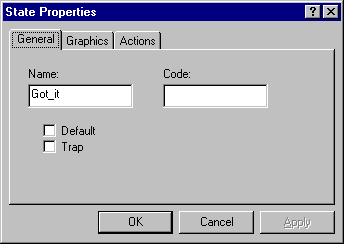
NOTES:
Since these actions need to be
executed only once while entering the state, the entry action
will be used.
To assign entry actions to the state, use the Actions
card in the State Properties window:
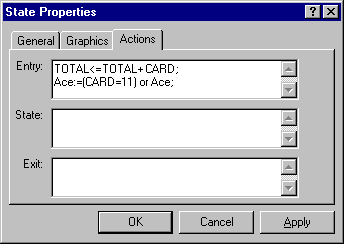
NOTE: The above described actions must be defined as entry actions. Otherwise, the total will be incremented on each active clock edge as long as the machine remains in the Got_it state.
The state diagram should now look as shown below:

Once the new card has been received, the total card score should be updated and tested. If it is less then 17, the state machine should request a new card and go back to the Hit_me state.
Adding a new card:
NOTE: Adding the NEW_CARD=’0" condition prevents the state machine from using the same card more than once.
After completing this step the state diagram will look as shown below:
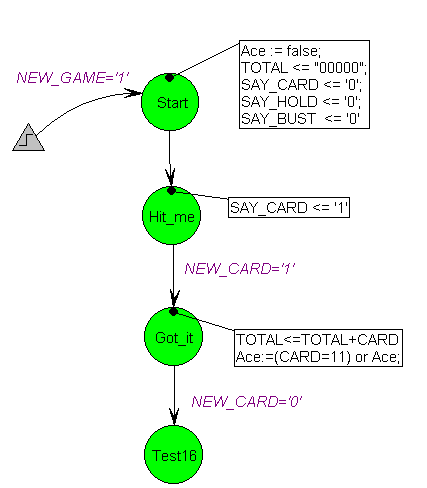
Detecting Hold/Bust conditions:
NOTE: The @ELSE transition is executed when no other conditions are met in this state. This transition will be executed if the TOTAL value is 16 or less and will cause the machine to request a new card in the Hit_me state.
The state diagram with the 5 states should look the following:
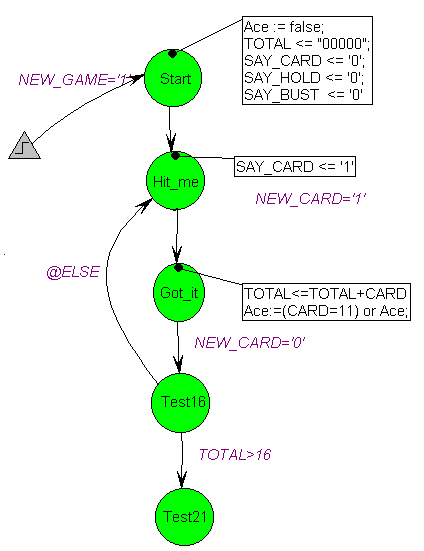
Once the machine gets to the Test 21 state, the total score is 17 or more. Now the state machine has to test if it has not exceeded 21. If not, it will flag the SAY_HOLD signal. If the score is over 21, the SAY_BUST signal should be activated, indicating that the machine has lost the game. Before flagging the SAY_BUST signal, the machine should check if any of the previously drawn cards was ACE. If there was Ace, it may decrement the total value by 10 to recover from the "bust" situation.

NOTE: Since ACE is a Boolean variable, no relational operators are required in the condition text.
NOTE: Transition actions allow to avoid redundant states. If you did not assign this action to a transition, another state would have to be created to execute the TOTAL <= TOTAL-10 action.
The final state diagram with all the states, transitions, conditions, and actions should look as shown below:
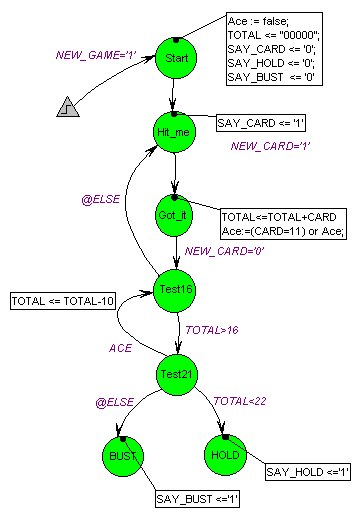
Assigning Condition Priorities
Note that in the Test21
state, both the TOTAL < 22 and ACE conditions
can be met at the same time. In such a case, behavior of the
machine depends on condition evaluation sequence. To avoid
confusion, you should assign different priorities to each
transition. Because our machine should first check if TOTAL is
less than 22, assign the priority 1 to the "Test21 Þ Hold" transition and
the priority 2 to the "Test21 Þ Test16" transition.
To change the transition priority:
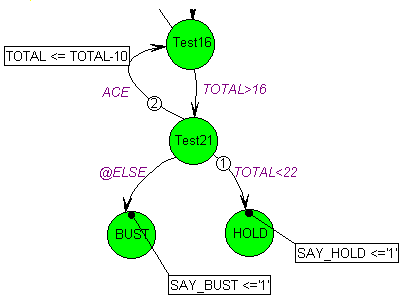
NOTE: Transitions without assigned priority are executed last.
When state machines are compiled
into logic, the current states are stored in a "state" register,
being a group of flip-flops. Each state is assigned to a separate
flip-flop. However, if there are some concurrent state
transitions, they may create a glitch in the combinatorial logic
and the state machine can enter a wrong state. The recommended
encoding type for all FPGAs is One-Hot which assigns such
values to each state so that only one bit of a register
transitions at any given time. One -Hot encoding, however,
consumes more flip-flops because each state requires a bit in a
register. For that reason it is not recommended for CPLDs which
lack flip flop resources. State Editor supports one-hot and
binary encoding. Other types of encoding can be created by manual
assigning codes to each state.
The binary encoding method will be used in this tutorial to
simplify design analysis in the simulator.
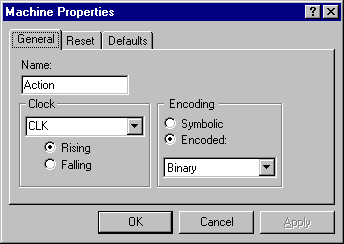
NOTE: The Symbolic encoding command allows the synthesis tool to automatically select the preferred state encoding method. Metamor XVHDL defaults to binary encoding if the codes are not assigned to any values.
To compile the design, choose Compile
from the Design menu or click the ![]() button. AVHDL will automatically generate
VHDL code corresponding to the state diagram.
button. AVHDL will automatically generate
VHDL code corresponding to the state diagram.
Locating and Correcting Errors
The output ports cannot be used
for reading by a state machine. If reading of a port is required,
it should be defined as bi-directional. Note that the 'TOTAL'
signal is not readable because it is in the OUT mode and an error
will be reported every time TOTAL appears on the right-hand side
of signal assignment.
To correct this error:
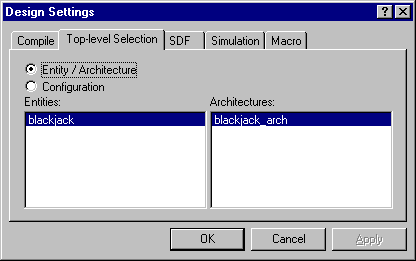
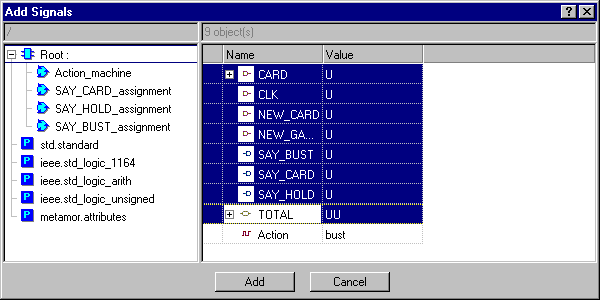
To assign stimulators to the signals:
Using the procedure described
above, assign the following stimulators to the signals:
| NEW_CARD | 0 0, 1 80 -r 100 |
| NEW_GAME | 1 0, 0 20 -r 600 |
| CARD | 16#0 0, 16#A 100, 16#3 200, 16#8 300 |
| CLK | 0 0, 1 5 -r 10 |
The above formulas are based on a
very simple syntax:
value [ time { , value time } [ -r period ] ]
where:
[ ] Square brackets indicate an optional item
{ } Braces indicate an optional item which can be repeated
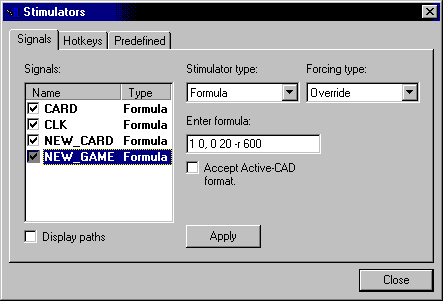
The signal names in the Waveform window should look as below:
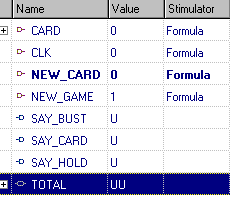
You should get results similar to the shown below:

As shown above, the State Editor is a powerful tool for creating control logic designs in VHDL. The graphical diagrams provide excellent documentation of the design and allow you to generate efficient and reliable synthesis results.